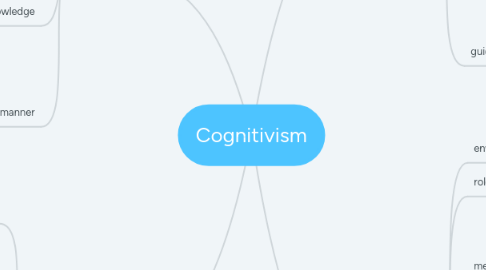
1. Learning
1.1. acquisition of knowledge
1.1.1. internal mental structures
1.1.1.1. epistemology continuum
1.2. equated
1.2.1. discrete changes
1.2.1.1. states of knowledge
1.3. focus
1.3.1. conceptualization of student's learning process
1.3.2. address issues of info
1.3.2.1. received
1.3.2.2. organized
1.3.2.3. stored
1.3.2.4. retrieved
1.3.2.5. by the mind
1.4. concerned with
1.4.1. what learners know
1.4.2. how they acquire it
1.5. guiding students
1.5.1. instructional explanations
1.5.2. demonstrations
1.5.3. illustrative examples
1.5.4. matched non-examples
2. Influence
2.1. enviornmental conditions
2.2. role of practice
2.2.1. corrective feedback
2.3. mental activities of learner
2.3.1. response
2.3.2. process of mental planning
2.3.3. goal-setting
2.3.4. organizational strategies
2.4. key elements
2.4.1. learners attending
2.4.1.1. code
2.4.1.2. transform
2.4.1.3. rehearse
2.4.1.4. store/retrieve info
2.5. learners
2.5.1. thoughts
2.5.2. beliefs
2.5.3. attitudes
2.5.4. values
2.6. encouragement
3. Transfer
3.1. info stored in memory
3.2. applying knowledged in different contexts
3.3. understanding
3.3.1. knowledge based
3.3.1.1. rules
3.3.1.2. concepts
3.3.1.3. discriminations
3.4. prior knowledge
3.4.1. establish boundary constraints
3.4.1.1. similarities/differences
3.4.1.1.1. novel info
3.4.2. stored in memory
3.4.3. triggered responses
3.4.3.1. specific instruction
3.4.3.2. real-word
3.5. efficient/effective manner
3.5.1. simplification
3.5.2. standardization
4. Types of learning
4.1. complex forms
4.1.1. reasoning
4.1.2. problem-solving
4.1.3. information-processing
4.2. instruction
4.2.1. existing mental structures
4.2.2. schema
4.3. strategies
4.3.1. framing
4.3.2. outlining
4.3.3. mnemonics
4.3.4. concept mapping
4.3.5. advance organizers

